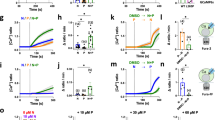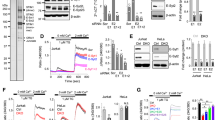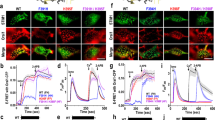Abstract
Stromal interacting molecule 1 (STIM1) is a Ca2+ sensor that conveys the Ca2+ load of the endoplasmic reticulum to store-operated channels (SOCs) at the plasma membrane. Here, we report that STIM1 binds TRPC1, TRPC4 and TRPC5 and determines their function as SOCs. Inhibition of STIM1 function inhibits activation of TRPC5 by receptor stimulation, but not by La3+, suggesting that STIM1 is obligatory for activation of TRPC channels by agonists, but STIM1 is not essential for channel function. Through a distinct mechanism, STIM1 also regulates TRPC3 and TRPC6. STIM1 does not bind TRPC3 and TRPC6, and regulates their function indirectly by mediating the heteromultimerization of TRPC3 with TRPC1 and TRPC6 with TRPC4. TRPC7 is not regulated by STIM1. We propose a new definition of SOCs, as channels that are regulated by STIM1 and require the store depletion-mediated clustering of STIM1. By this definition, all TRPC channels, except TRPC7, function as SOCs.
This is a preview of subscription content, access via your institution
Access options
Subscribe to this journal
Receive 12 print issues and online access
$209.00 per year
only $17.42 per issue
Buy this article
- Purchase on Springer Link
- Instant access to full article PDF
Prices may be subject to local taxes which are calculated during checkout







Similar content being viewed by others
References
Parekh, A. B. & Putney, J. W., Jr. Store-operated calcium channels. Physiol. Rev. 85, 757–810 (2005).
Berridge, M. J., Bootman, M. D. & Roderick, H. L. Calcium signalling: dynamics, homeostasis and remodelling. Nature Rev. Mol. Cell Biol. 4, 517–529 (2003).
Vig, M. et al. CRACM1 is a plasma membrane protein essential for store-operated Ca2+ entry. Science 312, 1220–1223 (2006).
Smyth, J. T. et al. Emerging perspectives in store-operated Ca2+ entry: roles of Orai, Stim and TRP. Biochim. Biophys. Acta. 1763, 1147–1160 (2006).
Soboloff, J., Spassova, M. A., Dziadek, M. A. & Gill, D. L. Calcium signals mediated by STIM and Orai proteins — a new paradigm in inter-organelle communication. Biochim. Biophys. Acta 1763, 1161–1168 (2006).
Mercer, J. C. et al. Large store-operated calcium selective currents due to co-expression of Orai1 or Orai2 with the intracellular calcium sensor, Stim1. J. Biol. Chem. 281, 24979–24990 (2006).
Feske, S. et al. A mutation in Orai1 causes immune deficiency by abrogating CRAC channel function. Nature 441, 179–185 (2006).
Zhang, S. L. et al. Genome-wide RNAi screen of Ca2+ influx identifies genes that regulate Ca2+ release-activated Ca2+ channel activity. Proc. Natl Acad. Sci. USA 103, 9357–9362 (2006).
Pedersen, S. F., Owsianik, G. & Nilius, B. TRP channels: an overview. Cell Calcium 38, 233–252 (2005).
Takahashi, Y. et al. Essential role of the N-terminus of murine Orai1 in store-operated Ca2+ entry. Biochem. Biophys Res. Comm. 356, 45–52 (2007).
Minke, B. TRP channels and Ca2+ signaling. Cell Calcium 40, 261–275 (2006).
Kiselyov, K., Kim, J. Y., Zeng, W. & Muallem, S. Protein-protein interaction and functionTRPC channels. Pflugers Arch. 451, 116–124 (2005).
Freichel, M. et al. Lack of an endothelial store-operated Ca2+ current impairs agonist-dependent vasorelaxation in TRP4−/− mice. Nature Cell Boil. 3, 121–127 (2001).
Dietrich, A. et al. Increased vascular smooth muscle contractility in TRPC6−/− mice. Mol. Cell. Biol. 25, 6980–6989 (2005).
Zagranichnaya, T. K., Wu, X. & Villereal, M. L. Endogenous TRPC1, TRPC3, and TRPC7 proteins combine to form native store-operated channels in HEK-293 cells. J. Biol. Chem. 280, 29559–29569 (2005).
Hofmann, T. et al. Direct activation of human TRPC6 and TRPC3 channels by diacylglycerol. Nature 397, 259–263 (1999).
Okada, T. et al. Molecular and functional characterization of a novel mouse transient receptor potential protein homologue TRP7. J. Biol. Chem. 274, 27359–27370 (1999).
Kiselyov, K. et al. Functional interaction between InsP3 receptors and store-operated Htrp3 channels. Nature 396, 478–482 (1998).
Vazquez, G., Lievremont, J. P., St, J. B. G. & Putney, J. W., Jr. Human Trp3 forms both inositol trisphosphate receptor-dependent and receptor-independent store-operated cation channels in DT40 avian B lymphocytes. Proc. Natl Acad. Sci. USA 98, 11777–11782 (2001).
Trebak, M., Bird, G. S., McKay, R. R. & Putney, J. W., Jr. Comparison of human TRPC3 channels in receptor-activated and store-operated modes. J. Biol. Chem. 277, 21617–21623 (2002).
Boulay, G. Ca2+–calmodulin regulates receptor-operated Ca2+ entry activity of TRPC6 in HEK-293 cells. Cell Calcium 32, 201–207 (2002).
Dietrich, A., Chubanov, V., Kalwa, H., Rost, B. R. & Gudermann, T. Cation channels of the transient receptor potential superfamily: Their role in physiological and pathophysiological processes of smooth muscle cells. Pharmacol. Therap. 112, 744–760 (2006).
Lievremont, J. P., Bird, G. S. & Putney, J. W., Jr. Canonical transient receptor potential TRPC7 can function as both a receptor- and store-operated channel in HEK-293 cells. Am. J. Physiol. Cell Physiol. 287, C1709–C1716 (2004).
Roos, J. et al. STIM1, an essential and conserved component of store-operated Ca2+ channel function. J. Cell Biol. 169, 435–445 (2005).
Liou, J. et al. STIM is a Ca2+ sensor essential for Ca2+-store-depletion-triggered Ca2+ influx. Curr. Biol. 15, 1235–1241 (2005).
Wu, M. M., Buchanan, J., Luik, R. M. & Lewis, R. S. Ca2+store depletion causes STIM1 to accumulate in ER regions closely associated with the plasma membrane. J. Cell Biol. 174, 803–813 (2006).
Baba, Y. et al. Coupling of STIM1 to store-operated Ca2+ entry through its constitutive and inducible movement in the endoplasmic reticulum. Proc. Natl Acad. Sci. USA 103, 16704–16709 (2006).
Stathopulos, P. B., Li, G. Y., Plevin, M. J., Ames, J. B. & Ikura, M. Stored Ca2+ depletion-induced oligomerization of stromal interaction molecule 1 (STIM1) via the EF-SAM Region. J. Biol. Chem. 281, 35855–35862 (2006).
Soboloff, J. et al. Orai1 and STIM reconstitute store-operated calcium channel function. J. Biol. Chem. 281, 20661–20665 (2006).
Peinelt, C. et al. Amplification of CRAC current by STIM1 and CRACM1 (Orai1). Nature Cell Biol. 8, 771–773 (2006).
Huang, G. N. et al. STIM1 carboxyl-terminus activates native SOC, I(crac) and TRPC1 channels. Nature Cell Biol. 8, 1003–1010 (2006).
Lopez, J. J., Salido, G. M., Pariente, J. A. & Rosado, J. A. Interaction of STIM1 with endogenously expressed human canonical TRP1 upon depletion of intracellular Ca2+ stores. J. Biol. Chem. 281, 28254–28264 (2006).
Ong, H. L. et al. Dynamic assembly of TRPC1/STIM1/Orai1 ternary complex is involved in store operated calcium influx: Evidence for similarities in SOC and CRAC channel components. J. Biol. Chem. 282, 9105–9116 (2007).
Wedel, B., Boyles, R. R., Putney, J. W. & Bird, G. S. Role of the store-operated calcium entry proteins, Stim1 and Orai1, in muscarinic-cholinergic receptor stimulated calcium oscillations in human embryonic kidney cells. J. Physiol. 579, 679–689 (2007).
Vazquez, G., Wedel, B. J., Trebak, M., St John Bird, G. & Putney, J. W., Jr. Expression level of the canonical transient receptor potential 3 (TRPC3) channel determines its mechanism of activation. J. Biol. Chem. 278, 21649–21654 (2003).
Xu, X. Z., Li, H. S., Guggino, W. B. & Montell, C. Coassembly of TRP and TRPL produces a distinct store-operated conductance. Cell 89, 1155–1164 (1997).
Liu, X., Bandyopadhyay, B. C., Singh, B. B., Groschner, K. & Ambudkar, I. S. Molecular analysis of a store-operated and 2-acetyl-sn-glycerol-sensitive non-selective cation channel. J. Biol. Chem. 280, 21600–21606 (2005).
Loessberg, P. A., Zhao, H. & Muallem, S. Synchronized oscillation of Ca2+ entry and Ca2+ release in agonist-stimulated AR42J cells. J. Biol. Chem. 266, 1363–1366 (1991).
Kiselyov, K., Wang, X., Shin, D. M., Zang, W. & Muallem, S. Calcium signaling complexes in microdomains of polarized secretory cells. Cell Calcium 40, 451–459 (2006).
Yeromin, A. V. et al. Molecular identification of the CRAC channel by altered ion selectivity in a mutant of Orai. Nature 443, 226–229 (2006).
Jung, S. et al. Lanthanides potentiate TRPC5 currents by an action at extracellular sites close to the pore mouth. J. Biol. Chem. 278, 3562–3571 (2003).
Vazquez, G., Bird, G. S., Mori, Y. & Putney, J. W., Jr. Native TRPC7 channel activation by an inositol trisphosphate receptor-dependent mechanism. J. Biol. Chem. 281, 25250–25258 (2006).
Yuan, J. P. et al. Homer binds TRPC family channels and is required for gating of TRPC1 by IP3 receptors. Cell 114, 777–789 (2003).
Kim, J. Y. et al. Homer 1 mediates store- and IP3Rs- dependent translocation and retrieval of TRPC3 to the plasma membrane. J. Biol. Chem. 281, 32540–32549 (2006).
Acknowledgements
We thank Y Mori for GFP–TRPC5, TRPC6 and TRPC7 plasmids. This work was supported in part by grant BGIA 06651924 from the Texas American Heart Association to W.Z., National Institutes of Health Grants DE12309 and DK38938 and the Ruth S. Harrell Professorship in Medical Research to S.M. and by the National Institute on Drug Abuse (NIDA; DA00266, DA10309) and the National Institute of Mental Health (NIMH; MH068830) to P.F.W.
Author information
Authors and Affiliations
Contributions
J.P.Y, W.Z and G.N.H performed and analysed the experiments. PF.W. and S.M. planned and analysed the experiments. All authors contributed to writing the manuscript.
Corresponding authors
Ethics declarations
Competing interests
The authors declare no competing financial interests.
Supplementary information
Supplementary Information
Supplementary figures S1 and S2 (PDF 711 kb)
Rights and permissions
About this article
Cite this article
Yuan, J., Zeng, W., Huang, G. et al. STIM1 heteromultimerizes TRPC channels to determine their function as store-operated channels. Nat Cell Biol 9, 636–645 (2007). https://doi.org/10.1038/ncb1590
Received:
Accepted:
Published:
Issue Date:
DOI: https://doi.org/10.1038/ncb1590
This article is cited by
-
STIM1-Orai1 interaction mediated calcium influx activation contributes to cardiac contractility of insulin-resistant rats
BMC Cardiovascular Disorders (2022)
-
Irisin mediates beiging of adipose-derived mesenchymal stem cells through binding to TRPC3
BMC Biology (2022)
-
Paraquat is an agonist of STIM1 and increases intracellular calcium levels
Communications Biology (2022)
-
Stromal interaction molecule 1 (STIM1) knock down attenuates invasion and proliferation and enhances the expression of thyroid-specific proteins in human follicular thyroid cancer cells
Cellular and Molecular Life Sciences (2021)
-
TRPC1 mediates slow excitatory synaptic transmission in hippocampal oriens/alveus interneurons
Molecular Brain (2020)



